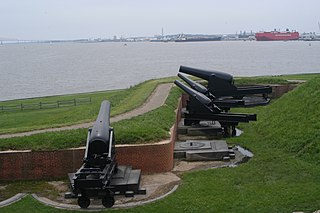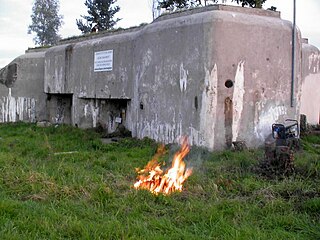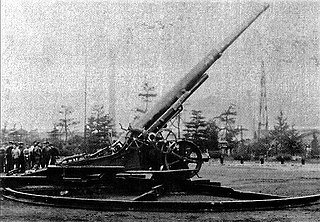Examples
The Japanese forces had built 17 "fortified districts" and over 4,500 permanent emplacements along the USSR border. Other similar structures were constructed inland in these provinces. In similar form it organized other fortified districts inside mainland Japan (coastal and inner mountainous areas) and overseas provinces (Taiwan, Ryukyu, South Seas Mandate, etc.)
Such installations that were constructed for defensive/offensive purposes were used by both sides. They were designed by the Japanese and used by the Russians during 'August Storm' operations in August 1945, when fire from heavy guns on land and coastal Tochkas was used against Japanese forces.
Examples of heavy Japanese fortified artillery:
- Type 94 37mm anti-tank (AT) Gun
- Type 1 37mm AT Gun
- Type 1 47mm AT Gun
- Type 92 70mm Infantry Gun
- Type 98 20mm AA Cannon
- Type 2 20mm AA Cannon
- Type 4 20mm AA Twin Cannon
- Type 11 75mm AA Gun
- Type 88 75mm AA Gun
- Type 4 75mm AA Gun
- Type 99 88mm AA Gun
- Type 14 10 cm AA Gun
- Type 3 12 cm AA Gun
- Type 5 15 cm AA Gun (Kugayama Cannon)
- 28 cm Heavy Howitzer
- Type 38 15 cm Howitzer
- Type 45 24 cm Howitzer
- Type 45 15 cm Gun
- Type 7 30 cm Howitzer
- Type 7 10 cm Gun
- Type 7 15 cm Gun
- Type 11 75mm Gun
- Type 89 15 cm Gun
- Type 96 24 cm Howitzer
- Type 96 15 cm Gun
- Experimental 41 cm Howitzer
- Type 90 24 cm Railway Gun (Futtsu Cannon)
- and other types of special heavy artillery
Examples remain in:
- Chosen Fortifications:
- Seishin (now Chongjin) with 4,000 officers and men, protected by heavy coastal artillery, an armored train, a regular train carrying combat equipment, and eight concrete fortifications and emplacements.
- Etetin (now Odetsin)
- Genzan (now Wonsan) with 6,238 Japanese officers and soldiers
- Rashin (now Najin)
- Yuki (called Unggi in Korean, now called Sonbong, or "Vanguard" in North Korea.)
- Manchoukouan Fortifications:
- Kwantung Fortifications:
Infantry support guns or battalion guns are artillery weapons designed and used to increase the firepower of the infantry units they are intrinsic to, offering immediate tactical response to the needs of the unit's commanding officer. They typically have short, low-velocity barrels, and light construction carriages, allowing them to be more easily manoeuvered on the battlefield. They are generally used for direct fire, rather than the indirect fire of other types of artillery. Their role has generally been replaced by tanks using tank guns, infantry fighting vehicles using autocannons, other combat vehicles, mortars, recoilless rifles, rocket-propelled grenades, and shoulder-launched missiles.

The Canon d'Infanterie de 37 modèle 1916 TRP was a French infantry support gun, first used during World War I. TRP stands for tir rapide, Puteaux. The tactical purpose of this gun was the destruction of machine gun nests.

Coastal artillery is the branch of the armed forces concerned with operating anti-ship artillery or fixed gun batteries in coastal fortifications.
The Karafuto Fortress was the defensive unit formed by the Karafuto fortification installations, and the Karafuto detachment of Japanese forces, the 88th Division. The headquarters was in Toyohara, capital of the province, based on the Suzuya plain, in the Southern Karafuto area, not far from the ports of Otomari and Maoka.
The Kita and Minami Fortresses were defensive structures of the Imperial Japanese Army and Imperial Japanese Navy in the Kuril Archipelago.

The Evacuation of Manchukuo occurred during the Soviet Red Army's invasion of the Japanese puppet state of Manchukuo as part of the wider Manchurian Strategic Offensive Operation of August 1945.

Seacoast defense was a major concern for the United States from its independence until World War II. Before airplanes, many of America's enemies could only reach it from the sea, making coastal forts an economical alternative to standing armies or a large navy. After the 1940s, it was recognized that fixed fortifications were obsolete and ineffective against aircraft and missiles. However, in prior eras foreign fleets were a realistic threat, and substantial fortifications were built at key locations, especially protecting major harbors.

The Fortified Sector of Altkirch was the French military organization that in 1940 controlled the section of the French frontier with Germany and Switzerland in the vicinity of Basel. The sector's principal defense against an advance from Germany was the Rhine itself, which could be crossed only by boat or by seizing a bridge crossing. The frontier with Switzerland was not regarded as a high-risk location, save for a possible advance by German forces through Switzerland. Originally planned as a full extension of the Maginot Line with artillery ouvrages, the sector's fortifications were scaled back and chiefly took the form of casemates and blockhouses. The SF Altkirch adjoined the Fortified Sector of Mulhouse to the north and the Fortified Sector of Montbéliard to the west.

The 28 cm howitzer L/10 was a Japanese coastal and siege howitzer. It was developed by Armstrong before 1892 and saw service in the Russo-Japanese War during the siege of Port Arthur and the Second Sino-Japanese War.

The Mortier de 270 mm modèle 1885 was a French heavy mortar employed as siege artillery during the First world war.

The Type 96 15 cm cannon was a siege gun used by the Imperial Japanese Army in the Japanese-Soviet War and during the Pacific War from 1936 to 1945. The designation Type 96 indicates the year of its introduction, Kōki year 2596 or 1936 according to Gregorian calendar.

The Type 96 24 cm howitzer was a siege gun used by the Imperial Japanese Army in the Japanese-Soviet War and during the Pacific War from 1936 to 1945. The designation Type 96 indicates the year of its introduction, Kōki year 2596 or 1936 according to Gregorian calendar.

Yura Fortress was the name of a group of coastal fortifications built to guard the entrance to Osaka Bay and thus the city of Osaka from attack from the sea. These gun batteries and fortifications ceased to be used after the end of World War II.

Shimonoseki Fortress was the name of a group of coastal fortifications built in the Meiji period to guard the entrance to Kanmon Straits separating Honshu and Kyushu, two of Japan's four main islands. These gun batteries and fortifications ceased to be used after the end of World War II.

Hōyo Fortress was the name of a group of coastal fortifications built to guard the Hōyo Strait at the entrance to Bungo Channel between the Japanese islands of Kyushu and Shikoku and this the western entrance to the Seto Inland Sea. These gun batteries and fortifications ceased to be used after the end of World War II.
This page is based on this
Wikipedia article Text is available under the
CC BY-SA 4.0 license; additional terms may apply.
Images, videos and audio are available under their respective licenses.











